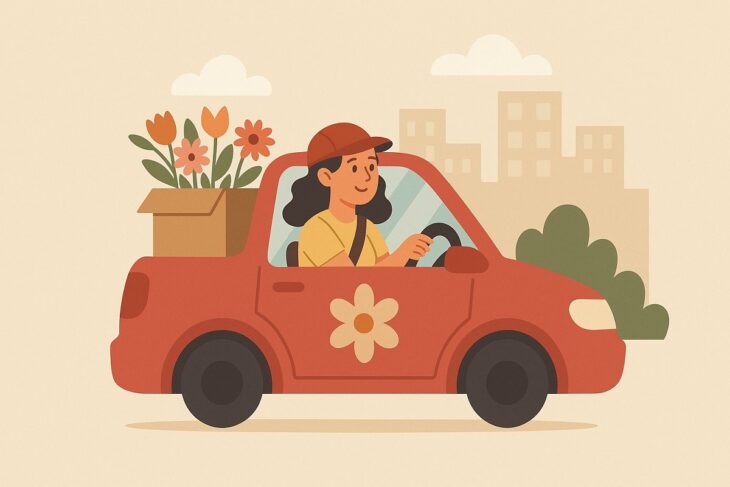Yes, you absolutely can start a flower delivery business using your car – and many people already are. W
hether you’re a florist looking to expand beyond your storefront, a side hustler exploring local opportunities, or someone with a green thumb and entrepreneurial spirit, using your vehicle for flower delivery is not only feasible – it can also be profitable, flexible, and scalable.
But there are important considerations around logistics, legality, insurance, and customer experience you’ll need to plan for.
Flowers remain a go-to gift for birthdays, anniversaries, sympathy occasions, and last-minute surprises. In the U.S. alone, the floral industry generates $5.9 billion annually, with over 36,000 floral businesses nationwide, according to IBISWorld.
And demand for same-day or local flower delivery has only increased since the pandemic-era boom in doorstep gifting.
Table of Contents
ToggleWhat You Need to Start Delivering Flowers from Your Car
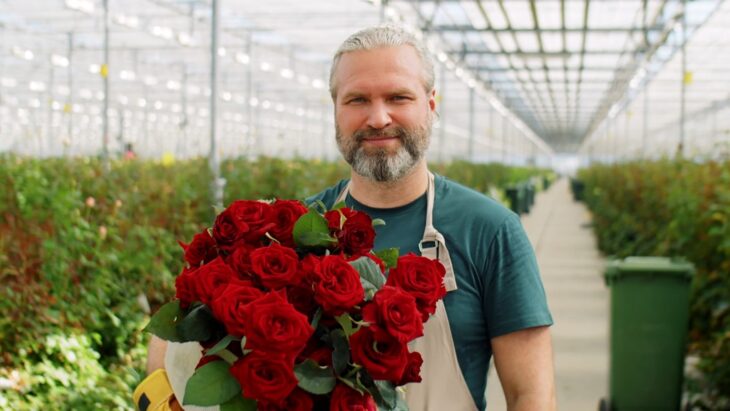
Starting up doesn’t require a storefront or a massive budget. Here’s what you’ll need to get rolling:
Basic Essentials:
- A clean, reliable vehicle with good climate control
- Space in the trunk or back seat for secure flower transport
- Buckets or containers to stabilize arrangements
- GPS routing or delivery management app (like Circuit or RoadWarrior)
- Floral supply source (either your arrangements or a partner florist)
- A basic website or ordering system (can be built free on platforms like Wix or Square)
Nice-to-Haves:
- Business cards or thank-you notes to include with deliveries
- Branded magnets or decals for your car
- SMS delivery notifications or tracking for customers
Legal and Insurance Considerations
Here’s where many people get tripped up: using your vehicle for business changes the legal equation. In most states, personal auto insurance does not cover accidents that occur while delivering for a business.
This is especially important if you’re transporting valuable cargo like wedding arrangements or delivering on behalf of a florist.
If something goes wrong, your insurer could deny your claim. That’s why you should explore:
- Commercial auto insurance
- Hired and non-owned auto insurance (HNOA)
- Adding a business use endorsement to your existing policy
Not sure what’s covered and what’s not? Click here to learn how using your car for business could impact your legal and financial responsibilities, especially if you’re ever involved in a car accident while delivering.
Startup Cost Breakdown (Using Your Car)
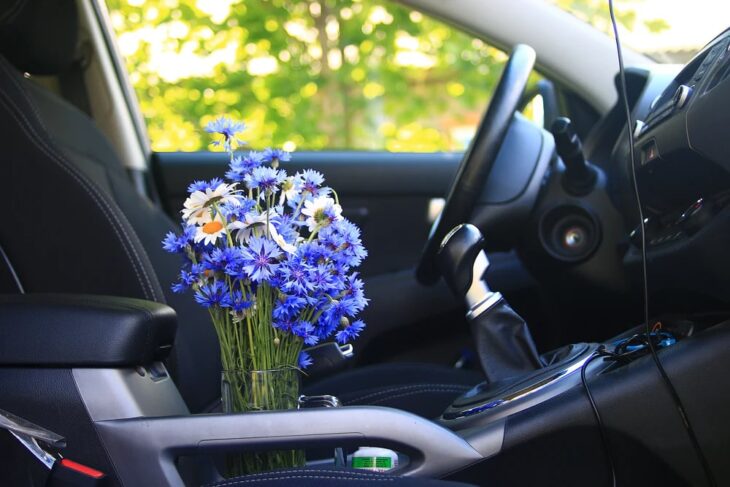
| Item | Estimated Cost |
| Business license/LLC | $50–$200 |
| Basic website/domain | $0–$100 |
| Containers/buckets | $30–$75 |
| Marketing materials | $50–$150 |
| Insurance adjustment | $100–$600/year |
| Fuel and maintenance | Variable |
You could realistically get started with under $500, especially if you’re creating simple arrangements from home or partnering with a local florist.
How Much Can You Make Delivering Flowers?
Earnings vary based on volume and location, but here’s a realistic example from a solo operator:
| Business Type | Weekly Deliveries | Average Sale | Weekly Revenue | Est. Profit (after gas/supplies) |
| Solo florist (home-based) | 20–25 | $55–$75 | $1,100–$1,875 | $650–$1,300/week |
| Delivery for a florist | 25–40 | $8–$12/delivery | $200–$480 | $150–$350/week |
Subscription models tend to provide the most predictable income, but freelance deliveries offer flexible scheduling and lower startup risk.
Ways to Structure Your Flower Delivery Business
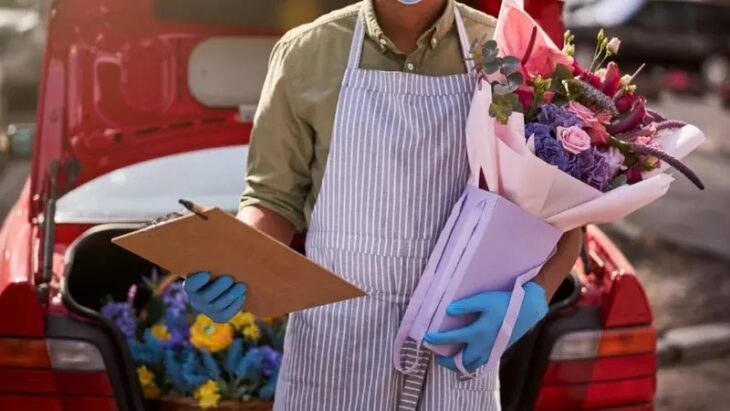
| Business Type | Creative Involvement | Earning Potential | Startup Effort | Ideal For |
| Freelance for Florists | Low | Medium | Low | Side hustlers, low-risk-takers |
| Independent Flower Seller | High | High | Medium–High | Creative entrepreneurs |
| Subscription Service | High | High (recurring) | Medium | Long-term income builders |
Freelance Delivery for Florists
One of the simplest ways to get started in the flower delivery space is by partnering with local florists as a freelance driver.
Many shops don’t have the staff or bandwidth to handle same-day deliveries, and they often need reliable drivers during peak holidays like Valentine’s Day and Mother’s Day.
In this role, you’re responsible for picking up pre-arranged bouquets and transporting them to customers. You’re typically paid a flat fee per delivery or a mileage-based rate.
This model requires very little upfront investment and no floral design skills. It’s ideal for people who want a flexible side hustle or those who want to explore the floral industry before going all in. The downside? You won’t control pricing, branding, or the customer experience, and you may be competing with courier apps for gigs.
Independent Flower Seller
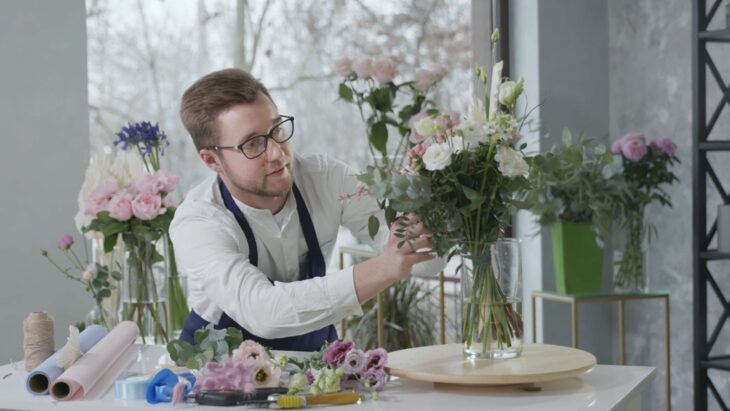
If you’re creatively inclined and want full ownership of the business, operating as an independent seller might be the best fit.
This approach means you’ll source your blooms – either through wholesale flower markets, local growers, or even your garden – and handle every part of the process.
You’ll be creating arrangements, promoting your brand on social media or through a website, taking customer orders, and delivering everything yourself. It’s a much more involved model, but it also comes with greater earning potential.
Because you’re in charge of the entire process, you can price according to value and offer custom services like event florals or sympathy bouquets.
You’ll also build personal relationships with customers, which is harder to do when working as a delivery contractor. This model works best when you’re able to manage creative tasks and logistics together, especially around holidays when volume spikes.
Subscription-Based Flower Service
A subscription model provides something every small business owner wants: recurring revenue. Instead of waiting for individual orders to come in, you offer a weekly or monthly delivery service.
Subscribers might include local businesses, real estate agents, boutique hotels, or flower lovers who simply want fresh arrangements at home.
The beauty of this structure is that you can batch deliveries on a set day, plan routes efficiently, and reduce waste by prepping in advance. You can also offer tiered pricing, such as small ($25/week), medium ($40/week), and deluxe ($60/week) packages.
While building a subscriber base takes time and trust, it offers long-term stability and a chance to become a staple in your community.
How to Keep Flowers Fresh in a Car
Temperature Control Is Key
Unlike groceries or packages, flowers are delicate and highly sensitive to environmental changes.
Temperature swings – especially excessive heat – can wilt petals and ruin an arrangement within minutes. That’s why having a vehicle with solid climate control is essential.
If you live in a hot or humid region, crack the windows slightly when parked or run the AC before loading in your arrangements. During winter, avoid blasting hot air directly onto the flowers.
Use Secure, Water-Friendly Containers
Transporting flowers loose in boxes or bags is asking for trouble. Instead, use deep buckets with water or foam stabilizers to keep stems upright and hydrated. Line your trunk or back seat with waterproof mats to prevent spills.
Some florists use milk crates or modular bins with flower foam to lock stems in place – this works especially well if you’re delivering multiple arrangements on one route. Make sure everything is padded to prevent tipping during sudden stops or turns.
Drive Carefully – Even on Familiar Roads
It might sound obvious, but careful driving makes a major difference. Accelerating too fast or braking hard can jostle arrangements or even topple entire buckets. Take turns slowly, avoid slamming on the brakes, and keep your delivery route calm and predictable.
For larger or event-style arrangements, it’s wise to call ahead and let the customer know you’re arriving so they can receive it immediately, especially for weddings or outdoor events where setup is time-sensitive.
Essential Freshness Tools to Keep On Hand
| Tool/Item | Purpose |
| Reflective windshield shade | Keeps the interior cooler when parked |
| Non-slip trunk liner | Prevents sliding during transport |
| Small cooler or chiller | Keeps delicate blooms fresh during long routes |
| Spray bottle with water | Refreshes flowers just before delivery |
| Flower delivery checklist | Ensures no order details are missed |
Final Thoughts
Starting a flower delivery business with your car is not only doable – it’s thriving in many areas where customers want local, personal service and don’t trust the big-name delivery apps.
You don’t need a floral design degree or thousands of dollars to get started. What you do need is consistency, care, a good eye for detail, and a safe, dependable vehicle.
